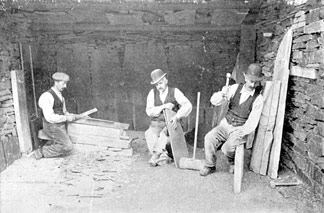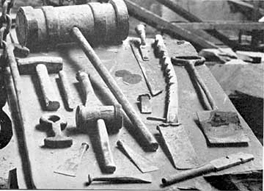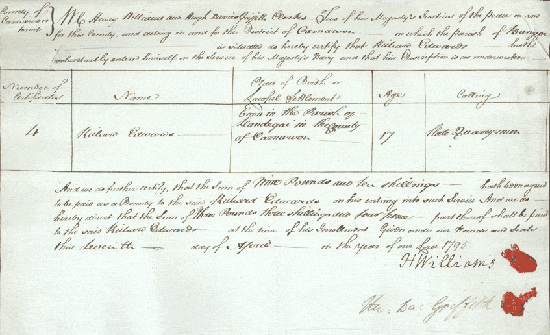Quarrying Techniques - The Workers
 (It is very important to bear in mind
that since the quarrying was a Welsh language industry, the
translations into English are only meant to give an idea of the
meaning of the original. These English versions are modern
literal translations. It is important to know that the
terminology did vary to some extent from area to area. The terms
used here are in the main from the Llanberis area.)
(It is very important to bear in mind
that since the quarrying was a Welsh language industry, the
translations into English are only meant to give an idea of the
meaning of the original. These English versions are modern
literal translations. It is important to know that the
terminology did vary to some extent from area to area. The terms
used here are in the main from the Llanberis area.)
Traditionally the quarrymen worked as partneriaid
(partners). It could be said that there were two groups
working at the quarries, ones who were always mewn clofar (in
clover), and the others as hogiau'r jacdo (jack daw
boys) as their future looked so black. To obtain a bargen
(bargain) of any value one had to go through the loaded
exercise or bargaining with the stiward gosod (setting
steward). Of course the setting price would have been worked
out at the quarry office before hand. Consequently, the quarry man
had to choice but to accept the price or lose his job. The term
bargen therefore was completely misleading. A
bargen was a face of rock around 2m wide, and would be set
out for a criw (crew) to work together in partnership. The
size of a criw could vary from two to a dozen. The steward
would price the bargen according to so much to the pound
(sterling).
 An eleven or
twelve year old boy would start work at the quarry as y
rybelwr (rubbler) learning the first elements of
hollti a naddu (splitting and chipping.) He
was indebted to the good will of the quarry man for slate that
would provide him with clytiau mân a chrawiau (lit.
slate that had already been split lengthwise to provide enough
material to be split into around 16 roofing slates and slate
which was split in a similar fashion but which could not
be used as roofing slate) to work on. By the time he was
between sixteen and twenty years old, he became a jermon
(journeyman.) His task would be to naddu wrth y dydd,
(chipping slates by the day for the quarry man.) An eleven or
twelve year old boy would start work at the quarry as y
rybelwr (rubbler) learning the first elements of
hollti a naddu (splitting and chipping.) He
was indebted to the good will of the quarry man for slate that
would provide him with clytiau mân a chrawiau (lit.
slate that had already been split lengthwise to provide enough
material to be split into around 16 roofing slates and slate
which was split in a similar fashion but which could not
be used as roofing slate) to work on. By the time he was
between sixteen and twenty years old, he became a jermon
(journeyman.) His task would be to naddu wrth y dydd,
(chipping slates by the day for the quarry man.)

Above: Quarter Sessions document recording a former quarryman
from Caernarfon entering service with the Navy in 1795.
Video:
See the Quarryman at his trade (Low Quality)
[To watch videos contained in this site you will need to use
either the Internet Explorer 4.0 + or Netscape Navigator 4.7+
browser. You must also have Windows Media Player 7.1 installed on
your system (this is already installed on most Windows systems)
or have the Windows Media Player plug-in installed (Netscape and
Macintosh users). If, when clicking on a clip you are informed
that you need to upgrade your player then you will need to visit
the Microsoft Windows Media Home website. Click
here to visit the Microsoft Windows Media Home website.]
|